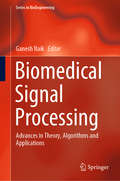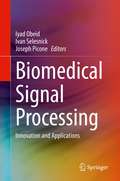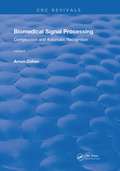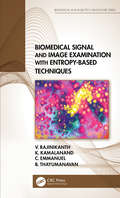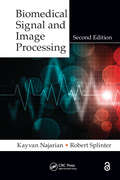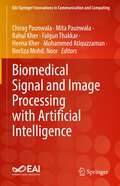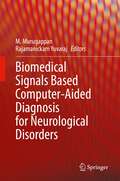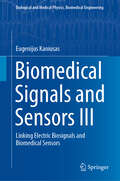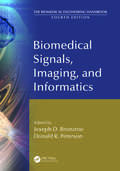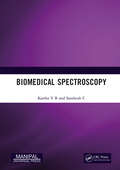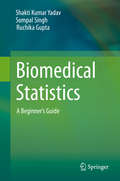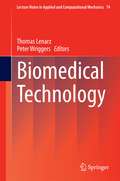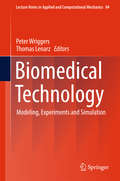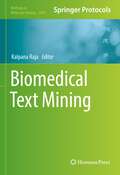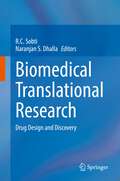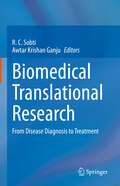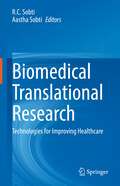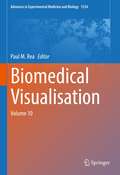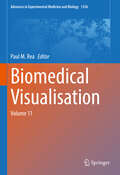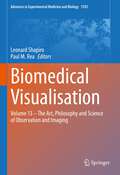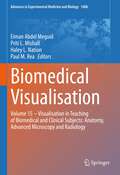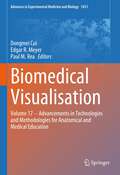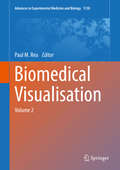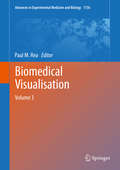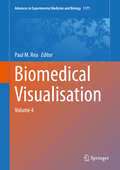- Table View
- List View
Biomedical Signal Processing: Advances in Theory, Algorithms and Applications (Series in BioEngineering)
by Ganesh NaikThis book reports on the latest advances in the study of biomedical signal processing, and discusses in detail a number of open problems concerning clinical, biomedical and neural signals. It methodically collects and presents in a unified form the research findings previously scattered throughout various scientific journals and conference proceedings. In addition, the chapters are self-contained and can be read independently. Accordingly, the book will be of interest to university researchers, R&D engineers and graduate students who wish to learn the core principles of biomedical signal analysis, algorithms, and applications, while also offering a valuable reference work for biomedical engineers and clinicians who wish to learn more about the theory and recent applications of neural engineering and biomedical signal processing.
Biomedical Signal Processing: Innovation and Applications
by Iyad Obeid Ivan Selesnick Joseph PiconeThis book provides an interdisciplinary look at emerging trends in signal processing and biomedicine found at the intersection of healthcare, engineering, and computer science. It examines the vital role signal processing plays in enabling a new generation of technology based on big data, and looks at applications ranging from medical electronics to data mining of electronic medical records. Topics covered include analysis of medical images, machine learning, biomedical nanosensors, wireless technologies, and instrumentation and electrical stimulation. Biomedical Signal Processing: Innovation and Applications presents tutorials and examples of successful applications, and will appeal to a wide range of professionals, researchers, and students interested in applications of signal processing, medicine, and biology.
Biomedical Signal Processing: Volume 2: Compression and Automatic Recognition (Routledge Revivals)
by Arnon CohenFirst published in 1986: The presentation of the material in the book follows the flow of events of the general signal processing system. After the signal has been acquired, some manipulations are applied in order to enhance the relevant information present in the signal. Simple, Optimal, and adaptive filtering are examples of such manipulations. The detection of wavelets is of importance in biomedical signals; they can be detected from the enhanced signal by several methods. The signal very often contains redundancies. When effective storing, transmission, or automatic classification are required, these redundancies have to be extracted.
Biomedical Signal and Image Examination with Entropy-Based Techniques (Biomedical and Robotics Healthcare)
by B. Thayumanavan V. Rajinikanth K. Kamalanand C. EmmanuelThe aim of this book is to outline the concept of entropy, various types of entropies and their implementation to evaluate a variety of biomedical signals/images. The book emphasizes various entropy-based image pre-processing methods which are essential for the development of suitable computerized examination systems. The recent research works on biomedical signal evaluation confirms that signal analysis provides vital information regarding the physiological condition of the patient, and the efficient evaluation of these signals can help to diagnose the nature and the severity of the disease. This book emphasizes various entropy-based image pre-processing methods which are essential for the development of suitable computerized examination systems for the analysis of biomedical images recorded with a variety of modalities. The work discusses the image pro-processing methods with the Entropies, such as Kapur, Tsallis, Shannon and Fuzzy on a class of RGB-scaled and gray-scaled medical pictures. The performance of the proposed technique is justified with the help of suitable case studies, which involves x-ray image analysis, MRI analysis and CT analysis. This book is intended for medical signal/image analysts, undergraduate and postgraduate students, researchers, and medical scientists interested in biomedical data evaluation.
Biomedical Signal and Image Processing
by Robert Splinter Kayvan NajarianWritten for senior-level and first year graduate students in biomedical signal and image processing, this book describes fundamental signal and image processing techniques that are used to process biomedical information. The book also discusses application of these techniques in the processing of some of the main biomedical signals and images, such as EEG, ECG, MRI, and CT. New features of this edition include the technical updating of each chapter along with the addition of many more examples, the majority of which are MATLAB based.
Biomedical Signal and Image Processing with Artificial Intelligence (EAI/Springer Innovations in Communication and Computing)
by Mohammed Atiquzzaman Rahul Kher Falgun Thakkar Chirag Paunwala Heena Kher Mita Paunwala Norliza Mohd. NoorThis book focuses on advanced techniques used for feature extraction, analysis, recognition, and classification in the area of biomedical signal and image processing. Contributions cover all aspects of artificial intelligence, machine learning, and deep learning in the field of biomedical signal and image processing using novel and unexplored techniques and methodologies. The book covers recent developments in both medical images and signals analyzed by artificial intelligence techniques. The authors also cover topics related to development based artificial intelligence, which includes machine learning, neural networks, and deep learning. This book will provide a platform for researchers who are working in the area of artificial intelligence for biomedical applications.Provides insights into medical signal and image analysis using artificial intelligence;Includes novel and recent trends of decision support system for medical research;Outlines employment of evolutionary algorithms for biomedical data, big data analysis for medical databases, and reliability, opportunities, and challenges in clinical data.
Biomedical Signals Based Computer-Aided Diagnosis for Neurological Disorders
by M. Murugappan Rajamanickam YuvarajBiomedical signals provide unprecedented insight into abnormal or anomalous neurological conditions. The computer-aided diagnosis (CAD) system plays a key role in detecting neurological abnormalities and improving diagnosis and treatment consistency in medicine. This book covers different aspects of biomedical signals-based systems used in the automatic detection/identification of neurological disorders. Several biomedical signals are introduced and analyzed, including electroencephalogram (EEG), electrocardiogram (ECG), heart rate (HR), magnetoencephalogram (MEG), and electromyogram (EMG). It explains the role of the CAD system in processing biomedical signals and the application to neurological disorder diagnosis. The book provides the basics of biomedical signal processing, optimization methods, and machine learning/deep learning techniques used in designing CAD systems for neurological disorders.
Biomedical Signals and Sensors III: Linking Electric Biosignals and Biomedical Sensors (Biological and Medical Physics, Biomedical Engineering)
by Eugenijus KaniusasAs the third volume in the author’s series on “Biomedical Signals and Sensors,” this book explains in a highly instructive way how electric, magnetic and electromagnetic fields propagate and interact with biological tissues. The series provides a bridge between physiological mechanisms and theranostic human engineering. The first volume focuses on the interface between physiological mechanisms and the resultant biosignals that are commonplace in clinical practice. The physiologic mechanisms determining biosignals are described from the cellular level up to the mutual coordination at the organ level. In turn, the second volume considers the genesis of acoustic and optic biosignals and the associated sensing technology from a strategic point of view. This third volume addresses the interface between electric biosignals and biomedical sensors. Electric biosignals are considered, starting with the biosignal formation path to biosignal propagation in the body and finally to the biosignal sensing path and the recording of the signal. The series also emphasizes the common features of acoustic, optic and electric biosignals, which are ostensibly entirely different in terms of their physical nature. Readers will learn how these electric, magnetic and electromagnetic fields propagate and interact with biological tissues, are influenced by inhomogeneity effects, cause neuromuscular stimulation and thermal effects, and finally pass the electrode/tissue boundary to be recorded. As such, the book helps them manage the challenges posed by the highly interdisciplinary nature of biosignals and biomedical sensors by presenting the basics of electrical engineering, physics, biology and physiology that are needed to understand the relevant phenomena.
Biomedical Signals, Imaging, and Informatics (The Biomedical Engineering Handbook, Fourth Edition)
by Joseph D. Bronzino Donald R. PetersonAs the third volume of The Biomedical Engineering Handbook, Fourth Edition, this book covers broad areas such as biosignal processing, medical imaging, infrared imaging, and medical informatics. More than three dozen specific topics are examined including biomedical signal acquisition, thermographs, infrared cameras, mammography, computed tomography, positron-emission tomography, magnetic resonance imaging, hospital information systems, and computer-based patient records. The material is presented in a systematic manner and has been updated to reflect the latest applications and research findings.
Biomedical Spectroscopy
by Kartha V B Santhosh CThis book discusses biomedical spectroscopy and the applications of spectroscopic techniques in advanced medical technology. Applicable to scientists and medical professionals, the aim of this work is to enable them to work together in this field, so that healthcare facilities can be made routinely available in a cost-effective manner—especially for developing countries which may not be able to afford universal healthcare with present day expensive medical technologies.The subject matter of this book also covers – Instrumentation, Experimental Techniques and Computational Methods Spectroscopy of Animal Models Microspectroscopy for Biomedical Applications Clinical Applications of Optical Spectroscopy Spectroscopy of Human Models Print edition not for sale in South Asia (India, Sri Lanka, Nepal, Bangladesh, Pakistan and Bhutan)
Biomedical Statistics: A Beginner's Guide
by Shakti Kumar Yadav Sompal Singh Ruchika GuptaThis book is written in a very easy-to-follow format, and explains the key concepts of biomedical statistics in a lucid yet straightforward manner. It explains how mathematical and statistical tools can be used to find answers to common research questions. In addition, the main text is supplemented by a wealth of solved exercises and illustrative examples to aid in comprehension. Given its content, the book offers an invaluable quick reference guide for graduating students and can be very helpful in their examination process. At the same time, it represents a handy guide for medical and paramedical teachers, post-graduate medical students, research personnel, biomedical scientists and epidemiologists.
Biomedical Technology: Modeling, Experiments And Simulation (Lecture Notes in Applied and Computational Mechanics #74)
by Thomas Lenarz Peter WriggersDuring the last years computational methods lead to new approaches that can be applied within medical practice. Based on the tremendous advances in medical imaging and high-performance computing, virtual testing is able to help in medical decision processes or implant designs. Current challenges in medicine and engineering are related to the application of computational methods to clinical medicine and the study of biological systems at different scales. Additionally manufacturers will be able to use computational tools and methods to predict the performance of their medical devices in virtual patients. The physical and animal testing procedures could be reduced by virtual prototyping of medical devices. Here simulations can enhance the performance of alternate device designs for a range of virtual patients. This will lead to a refinement of designs and to safer products. This book summarizes different aspects of approaches to enhance function, production, initialization and complications of different types of implants and related topics.
Biomedical Technology: Modeling, Experiments and Simulation (Lecture Notes in Applied and Computational Mechanics #84)
by Thomas Lenarz Peter WriggersDuring the last years computational methods lead to new approaches that can be applied within medical practice. Based on the tremendous advances in medical imaging and high-performance computing, virtual testing is able to help in medical decision processes or implant designs. Current challenges in medicine and engineering are related to the application of computational methods to clinical medicine and the study of biological systems at different scales. Additionally manufacturers will be able to use computational tools and methods to predict the performance of their medical devices in virtual patients. The physical and animal testing procedures could be reduced by virtual prototyping of medical devices. Here simulations can enhance the performance of alternate device designs for a range of virtual patients. This will lead to a refinement of designs and to safer products. This book summarizes different aspects of approaches to enhance function, production, initialization and complications of different types of implants and related topics.
Biomedical Text Mining (Methods in Molecular Biology #2496)
by Kalpana RajaThis volume details step-by-step instructions on biomedical literature mining protocols. Chapters guide readers through various topics such as, disease comorbidity, literature-based discovery, protocols to combine literature mining, machine learning for predicting biomedical discoveries, and uncovering unknown public knowledge by combining two pieces of information from different sets of PubMed articles. Additional chapters discuss the importance of data science to understand outbreaks such as COVID-19. Written in the format of the highly successful Methods in Molecular Biology series, each chapter includes an introduction to the topic, lists necessary materials and reagents, includes tips on troubleshooting and known pitfalls, and step-by-step, readily reproducible protocols. Authoritative and cutting-edge, Biomedical Text Mining aims to be a useful practical guide to researches to help further their studies.
Biomedical Translational Research: Drug Design and Discovery
by Naranjan S. Dhalla R. C. SobtiThis book, which is the third volume of Biomedical translational research, focuses on the fundamental role of biomedical research in developing new medicinal products. It emphasizes the importance of understanding biological and pathophysiological mechanisms underlying the disease to discover and develop new biological agents. The book uniquely explores the genomic computational integrative approach for drug repositioning. Further, it discusses the health benefits of nutraceuticals and their application in human diseases. Further, the book comprehensively reviews different computational approaches that employ GWAS data to guide drug repositioning. Finally, it summarizes the major challenges in drug development and the strategies for the rational design of the next generation more effective but less toxic therapeutic agents.
Biomedical Translational Research: From Disease Diagnosis to Treatment
by R. C. Sobti Awtar Krishan GanjuThe second volume of the Biomedical translational research discusses advancements in biomedical research for understanding the pathophysiology of various diseases towards improving diagnosis and treatment. It presents the integration of molecular-based technologies, clinical genomics, and medical informatics to improve diagnostic and treatment strategies. Further, the book reviews molecular genomics approaches for diagnosis and managing tuberculosis. It also covers the innovative strategies for cancer treatment through targeting metabolic pathways, tumor microenvironment, cancer stem cells, and immune cells. It also illuminates novel strategies for heart failure diagnosis and therapeutic approaches for the treatment of heart failure. It discusses improvements in translational research for discovery of new diagnostic tests, identifying novel biomarkers and drugable targets, and predicting optimal treatments based on understanding the underlying molecular basis of the disease. Lastly, it reviews the preclinical models of restenosis and their application and limitation in the evaluation of device-based interventional technologies for the treatment of coronary artery diseases.
Biomedical Translational Research: Technologies for Improving Healthcare
by R. C. Sobti Aastha SobtiThis book, which is the first volume of Biomedical Translational Research, summarizes emerging technologies in healthcare. The book reviews the advancements in biomedical sciences in genomics, immunology, stem cell, tissue engineering, nanotechnology, computational and structural biology, biomedical engineering, and telemedicine biology. The book highlights the applications of artificial intelligence in the diagnosis of infectious diseases and examines the role of system biology approaches for understanding human complexity, variability, and its influence on health and diseases. It presents the applications of flow cytometry in monitoring the progression and treatment of disease. It covers emerging technologies in cancer research, including CRISPR-Cas9, NGS, and nanotechnology. This book is a useful source of information for clinical researchers, basic scientists, biomedical engineers, and computational biologists.
Biomedical Visualisation: Volume 10 (Advances in Experimental Medicine and Biology #1334)
by Paul M. ReaThis edited book explores the use of technology to enable us to visualise the life sciences in a more meaningful and engaging way. It will enable those interested in visualisation techniques to gain a better understanding of the applications that can be used in visualisation, imaging and analysis, education, engagement and training. The reader will also be able to learn about the use of visualisation techniques and technologies for the historical and forensic settings.The reader will be able to explore the utilisation of technologies from a number of fields to enable an engaging and meaningful visual representation of the biomedical sciences. The chapters presented in this volume cover such a diverse range of topics, with something for everyone. We present here chapters on technology enhanced learning in neuroanatomy; 3D printing and surgical planning; changes in higher education utilising technology, decolonising the curriculum and visual representations of the human body in education. We also showcase how not to use protective personal equipment inspired by the pandemic; anatomical and historical visualisation of obstetrics and gynaecology; 3D modelling of carpal bones and augmented reality for arachnid phobias for public engagement. In addition, we also present face modelling for surgical education in a multidisciplinary setting, military medical museum 3D digitising of historical pathology specimens and finally computational fluid dynamics.
Biomedical Visualisation: Volume 11 (Advances in Experimental Medicine and Biology #1356)
by Paul M. ReaThis edited book explores the use of technology to enable us to visualise the life sciences in a more meaningful and engaging way. It will enable those interested in visualisation techniques to gain a better understanding of the applications that can be used in visualisation, imaging and analysis, education, engagement and training. The reader will also be able to learn about the use of visualisation techniques and technologies for the historical and forensic settings.The chapters presented in this volume cover such a diverse range of topics, with something for everyone. We present here chapters on 3D visualising novel stent grafts to aid treatment of aortic aneuryms; confocal microscopy constructed vascular models in patient education; 3D patient specific virtual reconstructions in surgery; virtual reality in upper limb rehabilitation in patients with multiple sclerosis and virtual clinical wards. In addition, we present chapters in artificial intelligence in ultrasound guided regional anaesthesia; carpal tunnel release visualisation techniques; visualising for embryology education and artificial intelligence data on bone mechanics. Finally we conclude with chapters on visualising patient communication in a general practice setting; digital facial depictions of people from the past; instructor made cadaveric videos, novel cadaveric techniques for enhancing visualisation of the human body and finally interactive educational videos and screencasts. This book explores the use of technologies from a range of fields to provide engaging and meaningful visual representations of the biomedical sciences. It is therefore an interesting read for researchers, developers and educators who want to learn how visualisation techniques can be used successfully for a variety of purposes, such as educating students or training staff, interacting with patients and biomedical procedures in general.
Biomedical Visualisation: Volume 13 – The Art, Philosophy and Science of Observation and Imaging (Advances in Experimental Medicine and Biology #1392)
by Leonard Shapiro Paul M. ReaThis book brings together current advances in high-technology visualisation and the age-old but science-adapted practice of drawing for improved observation in medical education and surgical planning and practice. We begin this book with a chapter reviewing the history of confusion around visualisation, observation and theory, outlining the implications for medical imaging. The authors consider the shifting influence of various schools of philosophy, and the changing agency of technology over time. We then follow with chapters on the practical application of visualisation and observation, including emerging imaging techniques in anatomy for teaching, research and clinical practice - innovation in the mapping of orthopaedic fractures for optimal orthopaedic surgical guidance - placental morphology and morphometry as a prerequisite for future pathological investigations - visualising the dural venous sinuses using volume tracing. Two chapters explore the use and benefit of drawing in medical education and surgical planning. It is worth noting that experienced surgeons and artists employ a common set of techniques as part of their work which involves both close observation and the development of fine motor skills and sensitive tool use.An in-depth look at police identikit construction from memory by eyewitnesses to crimes, outlines how an individual’s memory of a suspect’s facial features are rendered visible as a composite image.This book offers anatomy educators and clinicians an overview of the history and philosophy of medical observation and imaging, as well as an overview of contemporary imaging technologies for anatomy education and clinical practice. In addition, we offer anatomy educators and clinicians a detailed overview of drawing practices for the improvement of anatomical observation and surgical planning. Forensic psychologists and law enforcement personnel will not only benefit from a chapter dedicated to the construction of facial composites, but also from chapters on drawing and observation.
Biomedical Visualisation: Volume 15 ‒ Visualisation in Teaching of Biomedical and Clinical Subjects: Anatomy, Advanced Microscopy and Radiology (Advances in Experimental Medicine and Biology #1406)
by Paul M. Rea Eiman Abdel Meguid Priti L. Mishall Haley L. NationThis book highlights the integration of science and imaging and demonstrates how we can teach and learn in a much more accessible, innovative, and engaging way using technology. This volume is particularly focused on three main themes: advanced microscopy, anatomy education, and radiology visualisation related to patient care. The chapters pertaining to advanced microscopy convey complex biomedical information by visual means. These chapters provide both an overview on the principles of microscopy and specific applications of microscopy that have led to groundbreaking discoveries. Chapters pertaining to education summarise the recent trends in teaching gross and microscopic anatomy and emphasise the creation and use of novel tools to support student learning. Lastly, the radiological visualisation segment dives into the history of radiographic imaging and highlights the profound effect technology has had on improving patient outcomes. This volume will be of particular interest to many; the scope of this book encompasses medicine, dentistry, allied health professions, biomedical sciences, anatomy and histology education, radiology, and microscopy. Students, researchers, educators, and clinicians will learn something new, be stimulated to ask innovative questions, and be inspired to continue the technological advancements pushing science forward.
Biomedical Visualisation: Volume 17 ‒ Advancements in Technologies and Methodologies for Anatomical and Medical Education (Advances in Experimental Medicine and Biology #1431)
by Paul M. Rea Dongmei Cui Edgar R. MeyerCurricula in the health sciences have undergone significant change and reform in recent years. The time allocated to anatomical education in medical, osteopathic medical, and other health professional programs has largely decreased. As a result, educators are seeking effective teaching tools and useful technology in their classroom learning.This edited book explores advances in anatomical sciences education, such as teaching methods, integration of systems-based components, course design and implementation, assessments, effective learning strategies in and outside the learning environment, and novel approaches to active learning in and outside the laboratory and classroom. Many of these advances involve computer-based technologies. These technologies include virtual reality, augmented reality, mixed reality, digital dissection tables, digital anatomy apps, three-dimensional (3D) printed models, imaging and 3D reconstruction, virtual microscopy, online teaching platforms, table computers and video recording devices, software programs, and other innovations. Any of these devices and modalities can be used to develop large-class practical guides, small-group tutorials, peer teaching and assessment sessions, and various products and pathways for guided and self-directed learning. The reader will be able to explore useful information pertaining to a variety of topics incorporating these advances in anatomical sciences education. The book will begin with the exploration of a novel approach to teaching dissection-based anatomy in the context of organ systems and functional compartments, and it will continue with topics ranging from teaching methods and instructional strategies to developing content and guides for selecting effective visualization technologies, especially in lieu of the recent and residual effects of the COVID-19 pandemic. Overall, the book covers several anatomical disciplines, including microscopic anatomy/histology, developmental anatomy/embryology, gross anatomy, neuroanatomy, radiological imaging, and integrations of clinical correlations.
Biomedical Visualisation: Volume 2 (Advances in Experimental Medicine and Biology #1138)
by Paul M. ReaThis edited book explores the use of technology to enable us to visualise the life sciences in a more meaningful and engaging way. It will enable those interested in visualisation techniques to gain a better understanding of the applications that can be used in visualisation, imaging and analysis, education, engagement and training. The reader will be able to explore the utilisation of technologies from a number of fields to enable an engaging and meaningful visual representation of the biomedical sciences. This use of technology-enhanced learning will be of benefit for the learner, trainer and faculty, in patient care and the wider field of education and engagement. This second volume on Biomedical Visualisation will explore the use of a variety of visualisation techniques to enhance our understanding of how to visualise the body, its processes and apply it to a real world context. It is divided into three broad categories – Education; Craniofacial Anatomy and Applications and finally Visual Perception and Data Visualization. In the first four chapters, it provides a detailed account of the history of the development of 3D resources for visualisation. Following on from this will be three major case studies which examine a variety of educational perspectives in the creation of resources. One centres around neuropsychiatric education, one is based on gaming technology and its application in a university biology curriculum, and the last of these chapters examines how ultrasound can be used in the modern day anatomical curriculum. The next three chapters focus on a complex area of anatomy, and helps to create an engaging resource of materials focussed on craniofacial anatomy and applications. The first of these chapters examines how skulls can be digitised in the creation of an educational and training package, with excellent hints and tips. The second of these chapters has a real-world application related to forensic anatomy which examines skulls and soft tissue landmarks in the creation of a database for Cretan skulls, comparing it to international populations. The last three chapters present technical perspetives on visual perception and visualisation. By detailing visual perception, visual analytics and examination of multi-modal, multi-parametric data, these chapters help to understand the true scientific meaning of visualisation. The work presented here can be accessed by a wide range of users from faculty and students involved in the design and development of these processes, to those developing tools and techniques to enable visualisation in the sciences.
Biomedical Visualisation: Volume 3 (Advances in Experimental Medicine and Biology #1156)
by Paul M. ReaThis edited book explores the use of technology to enable us to visualise the life sciences in a more meaningful and engaging way. It will enable those interested in visualisation techniques to gain a better understanding of the applications that can be used in visualisation, imaging and analysis, education, engagement and training.The reader will be able to explore the utilisation of technologies from a number of fields to enable an engaging and meaningful visual representation of the biomedical sciences, with a focus in this volume related to anatomy, and clinically applied scenarios.The first six chapters have an anatomical focus examining digital technologies and applications to enhance education. The first examines the history and development of ultrasound, applications in an educational setting, and as a point-of-care ultrasound at the bedside. The second chapter presents a transferable workflow methodology in creating an interactive educational and training package to enhance understanding of the circadian rhythm. The third chapter reviews tools and technologies, which can be used to enhance off-campus learning, and the current range of visualisation technologies like virtual, augmented and mixed reality systems. Chapter four discusses how scanning methodologies like CT imagery, can make stereoscopic models. The fifth chapter describes a novel way to reconstruct 3D anatomy from imaging datasets and how to build statistical 3D shape models, described in a clinical context and applied to diagnostic disease scoring. The sixth chapter looks at interactive visualisations of atlases in the creation of a virtual resource, for providing next generation interfaces.The seventh and eight chapters discuss neurofeedback for mental health education and interactive visual data analysis (applied to irritable bowel disease) respectively.The final two chapters examine current immersive technologies –virtual and augmented reality, with the last chapter detailing virtual reality in patients with dementia.This book is accessible to a wide range of users from faculty and students, developers and computing experts, the wider public audience. It is hoped this will aid understanding of the variety of technologies which can be used to enhance understanding of clinical conditions using modern day methodologies.
Biomedical Visualisation: Volume 4 (Advances in Experimental Medicine and Biology #1171)
by Paul M. ReaWith the rapid advances of technology, visualisation in the sciences using computers, is a rapidly expanding and evolving area. Visualisation in its broadest sense represents how objects, situations, applications, methodologies and information can be seen and presented. This proposal is to incorporate work in the field of biomedical visualisation and will encompass techniques of using computers to visualise information. This will include photogrammetry, virtual and augmented reality, 3D printing, e-tutorial and website design and digital reconstructions and animations. It will showcase research, innovations and current work in the field of biomedicine, life sciences, veterinary medicine and computing sciences presenting data in an innovative and engaging way to showcase complex data and information in an easier to access format.
